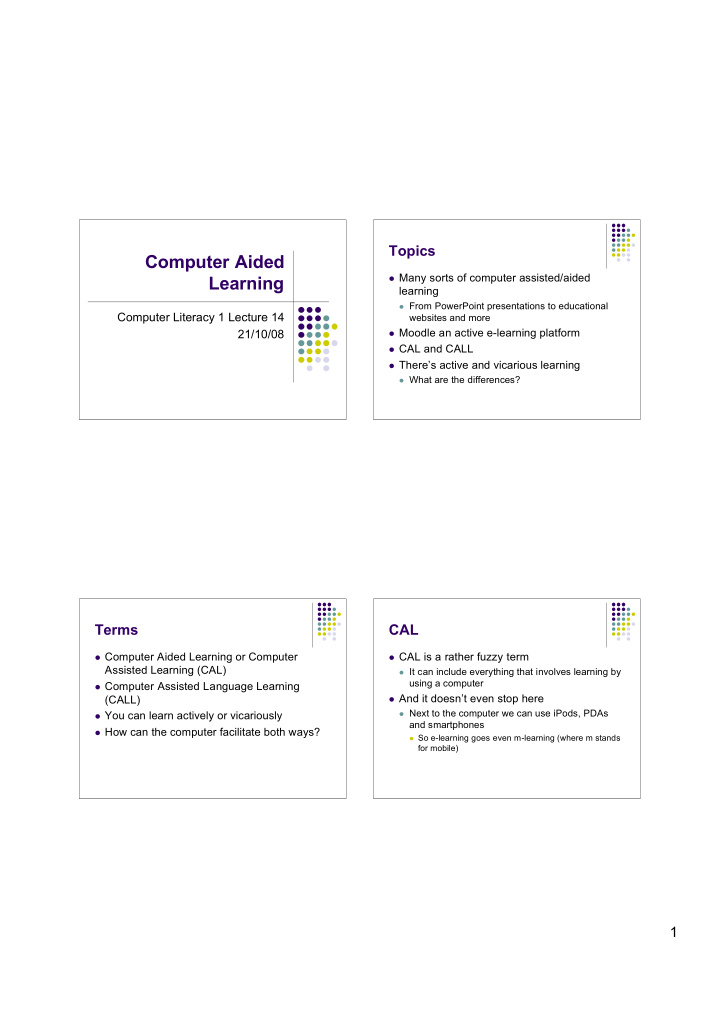



Topics Computer Aided Many sorts of computer assisted/aided Learning learning From PowerPoint presentations to educational Computer Literacy 1 Lecture 14 websites and more Moodle an active e-learning platform 21/10/08 CAL and CALL There’s active and vicarious learning What are the differences? Terms CAL Computer Aided Learning or Computer CAL is a rather fuzzy term Assisted Learning (CAL) It can include everything that involves learning by using a computer Computer Assisted Language Learning And it doesn’t even stop here (CALL) Next to the computer we can use iPods, PDAs You can learn actively or vicariously and smartphones How can the computer facilitate both ways? So e-learning goes even m-learning (where m stands for mobile) 1
JCAL Example for JCAL articles JCAL = Journal of Computer Assisted Learning These examples are taken from the current issue, Volume 24 issue 5 (October 2008), only article titles JCAL is published 6 times a year and also publishes are quoted regularly special issues to concentrate on only 1 topic per issue “Getting it from the Web: why and how online resources A short look at the table of contents of their current are used by independent undergraduate students” October issue shows you the variety of topics “The effects of animation on verbal interaction in computer covered by the term Computer Assisted Learning supported collaborative learning” “Critical issues for e-learning delivery: what may seem obvious is not always put into practice” CAL Moodle Moodel is also known as Course Like mentioned before CAL can cover a lot of e- Management System (CMS) learning categories So already the use of PowerPoint slides can be It’s a free and open-source e-learning seen as computer aided learning when used in software platform lecture or class Runs on all major platforms (Unix, Windows, Smartboards fall in this categorie Mac OS X) WebCT and MyEd does It’s SQL based As well as educational computer games and more Company based in Perth, Australia 2
Moodel a virtual learning environment More CAL Educators can create online courses Since we already talked about games in They can give these courses interactive education… opportunities Today we will have a look at software and For untrained users Moodle has something called a websites that facilitate learning in a more sandbox serious way In an online sandbox of this kind you can play around with the software to see if you can handle it Some topics are hard to cover in a game like Very similar to BlackBoard and WebCT scenario, e.g. law CAL software Active Learning Also interactive learning Software for chemistry learning This is the kind of learning where a learner is http://home.c2i.net/astandne/ actively involved in solving a task/problem TaxTrans: Computer Assisted Learning Interactivity takes place when the learner gets Software for the Analysis of Taxes and feedback Simple example for feedback from computer can be right or Transfers in General and Partial Equilibrium wrong without explaining why right or wrong http://ideas.repec.org/p/mlb/wpaper/762.html Sometimes it can be more sophisticated and computer can show you how to solve a problem step by step (which could overlap with vicarious learning) 3
CALL CALL Software Computer Assisted Language Learning For foreign students to learn for they TOEFL Is normally an active form of learning http://www- writing.berkeley.edu/chorus/call/reviews/toefl Since you should not only be able to read and _mentor/index.html write in a foreign language but also speak and understand it English students learning Chinese What makes it active? http://www- For example: You use a microphone to give your writing.berkeley.edu/chorus/call/reviews/archi computer language input in a foreign language ves/intchinese.html and the computer either accepts your pronunciation or not Brief introduction to EuroCall Vicarious Learning There is a European Association for Computer Assisted Learning They do amongst others: Derives from socio-cognitive psychology A. Bandura’s Bobo doll experiment: Provide a European focus on innovative research Children watched aggressive behaviour of adults and and development 1 copied this behaviour afterwards Enhance the quality, dissemination and efficiency Observational learning = Vicarious Learning of CALL materials 1 Support special interest groups 1 ( 1 http://www.eurocall-languages.org/about/index.html ) 4
YouTute: an Example for Bobo-doll experiment Vicarious Learning YouTute gives students the opportunity to watch themselves and other peers in their tutorials online This passive learning is augmented by the ability to select, structure and compare a range of learning experiences relating to a particular topic YouTute presents three synchronised videos from different angles of each tutorial together with related learning material, e.g. lecture slides and worksheets YouTute - Interface PATSy PATSy stands for Patient Assessment Training System It was developed for Speech and Language Therapy students PATSy should give the students the possibility to see and assess videos of “virtual” patients This system makes it easier to prepare students for their clinical work http://www.patsy.ac.uk/ 5
Key points http://www.blackwellpublishing.com/journal.asp?ref= 0266-4909 (link to JCALL Journal) CAL is covering a huge amount of categories You know a lot of tool used for CAL (from PPT to Moodle) CAL (like other learning) can be done actively or in a more passive way (vicariously) CALL needs to facilitate an active form of learning YouTute and PASTSy are learning facilitating interfaces designed for higher education 6
Recommend
More recommend